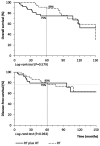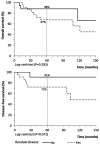Post-radiotherapy hysterectomy does not benefit females with cervical adenocarcinoma
- PMID: 33194198
- PMCID: PMC7657080
- DOI: 10.3892/mco.2020.2162
Post-radiotherapy hysterectomy does not benefit females with cervical adenocarcinoma
Abstract
Cervical adenocarcinoma is associated with a poor prognosis, which may be caused by the infiltrative growth pattern and metastasis of tumor cells. There is a lack of consensus on hysterectomy after radiotherapy for the improvement of selected cases. The present study aimed to assess the oncological outcome of post-radiotherapy hysterectomy in females with cervical adenocarcinoma. A total of 39 females with cervical adenocarcinoma at stages IB1 to IIIB, managed primarily with radiotherapy with complete response, and underwent extrafascial hysterectomy as consolidation therapy between 1988 to 2015 were studied. Surgery complications and residual disease were evaluated. A comparison group was constructed, comprising 41 females with cervical adenocarcinoma managed with exclusive radiotherapy or chemoradiotherapy demonstrating complete response, without surgery. Descriptive and survival analysis was performed. The groups were comparable in terms of age, cancer stage, radiotherapy (dose and duration) and follow-up, although 67% of hysterectomies were performed prior to 2002 and 46% of the radiotherapy group received chemoradiation. Late complications were similar. There were nine recurrences (23%) in the case series and 10 recurrences (24%) in the radiotherapy group. Residual disease was detected in 56% (22/39) of uterine specimens, of which 12 were up to 10 mm. Residual disease was associated with recurrence (31% vs. 6%, P=0.028). The overall survival rate was 75% for the case series vs. 88% for the radiotherapy group (P=0.579), and the disease-free survival rate was 79-80% for both. Removal of residual disease by hysterectomy did not improve the overall survival rate (P=0.283) and disease-free survival rate (P=0.072). Post-radiotherapy hysterectomy in cervical adenocarcinoma is a feasible procedure with acceptable complications, however, it did not bring relevant benefits in recurrences, disease-free survival, and overall survival rates.
Keywords: adenocarcinoma; cervical cancer; hysterectomy; radiotherapy; survival.
Copyright © 2020, Spandidos Publications.
Figures



References
-
- Castellsagué X, Díaz M, de Sanjosé S, Muñoz N, Herrero R, Franceschi S, Peeling RW, Ashley R, Smith JS, Snijders PJ, et al. Worldwide human papillomavirus etiology of cervical adenocarcinoma and its cofactors: Implications for screening and prevention. J Natl Cancer Inst. 2006;98:303–315. doi: 10.1093/jnci/djj067. - DOI - PubMed
-
- Keys HM, Bundy BN, Stehman FB, Okagaki T, Gallup DG, Burnett AF, Rotman MZ, Fowler WC Jr. Radiation therapy with and without extrafascial hysterectomy for bulky stage IB cervical carcinoma: A randomized trial of the gynecologic oncology group. Gynecol Oncol. 2003;89:343–353. doi: 10.1016/s0090-8258(03)00173-2. Gynecologic Oncology Group. - DOI - PubMed
-
- Zhou J, Wu SG, Sun JY, Li FY, Lin HX, Chen QH, He ZY. Comparison of clinical outcomes of squamous cell carcinoma, adenocarcinoma, and adenosquamous carcinoma of the uterine cervix after definitive radiotherapy: A population-based analysis. J Cancer Res Clin Oncol. 2017;143:115–122. doi: 10.1007/s00432-016-2246-9. - DOI - PMC - PubMed
LinkOut - more resources
Full Text Sources
